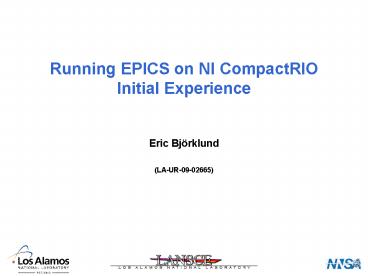Running EPICS on NI CompactRIO - PowerPoint PPT Presentation
Title:
Running EPICS on NI CompactRIO
Description:
Running EPICS on NI CompactRIO Initial Experience Eric Bj rklund (LA-UR-09-02665) What is CompactRIO? Power-PC based Real Time Controller (RTC). FPGA Backplane ... – PowerPoint PPT presentation
Number of Views:119
Avg rating:3.0/5.0
Title: Running EPICS on NI CompactRIO
1
Running EPICS on NI CompactRIO Initial Experience
Eric Björklund (LA-UR-09-02665)
2
What is CompactRIO?
- Power-PC based Real Time Controller (RTC).
- FPGA Backplane
- Connected via PCI bus
- Designed for harsh environments
- Fast PLC
- ?Sec vs. mSec Response
- Programmed in LabVIEW instead of Ladder Logic
- Both FPGA and RTC are programmed in LabVIEW
3
Advantages to Running EPICS IOC on CompactRIO
- Faster and more deterministic data acquisition
and control - No intermediate ethernet hop (as with EtherIP)
- Could consider EPICS closed loop control
- Flexibility
- Application can be partitioned between LabVIEW
and EPICS whichever way makes the most sense. - FPGA runs independently from Power PC
- Critical system functions can survive soft reboot.
4
What does it take to run EPICS IOC on CompactRIO?
- Real Time Controller (RTC) is a Power PC (ppc603)
running vxWorks (6.3) - vxWorks license not required!
- NI has permission to distribute the vxWorks
header files - Began working on project in late 2007
- National Instruments, LANSCE, and Cosylab
collaboration - Cosylab Provided
- Custom version of cRIO BSP that included NFS and
Telnet - Shared memory library similar to the SNS
LabVIEW/EPICS shared memory interface. - EPICS runs at lower priority (100-199) than
LabVIEW (10-100)
5
What do you need to run EPICS on CompactRIO?
- EPICS-Enabled vxWorks BSP for the cRIO
(Cosylab/NI) - LabVIEW 8.6.1 (although we use 8.5.1 for our
prototype system) - vxWorks header files (NI can supply)
- vxWorks 6.3 for LabVIEW 8.5.1 vxWorks 6.6 for
LabVIEW 8.6.1 - Configuration files (if you arent running the
same version of vxWorks as the cRIO) - We copied the ppc603_long configuration files
and pointed them to the vxWorks 6.3 headers. - CONFIG.Common.vxWorks-cRIO
- CONFIG_SITE.Common.vxWorks-cRIO
- CONFIG_SITE.linux-x86_64.vxWorks-cRIO
- CONFIG_SITE.linux-x86.vxWorks-cRIO
- CONFIG_SITE.win32-x86.vxWorks-cRIO
- Shared Memory Library (actually two librarys)
6
Shared Memory Library Two Parts
The LabVIEW Part
EPICS Part
- vxWorks only (no EPICS calls)
- Allocates and manages shared memory resources
- Interfaces to LabVIEW through Call Library
Function Node VIs - Lives on RTCs non-volatile RAM disk.
- Automatically loaded when the RTC VI that
references it is run. - Two forms
- vxWorks shared library (.out) for run-time (munch
file works fine) - Windows .DLL for compile time (this can be just a
stub)
- EPICS Device Support Layer
- Interfaces to LabVIEW library for access to
shared memory resources. - Built into the EPICS application and loaded over
the network with the EPICS application code. - EPICS database records not automatically created
(as with SNS system)
7
Shared Memory Interface (as seen from LabVIEW)
- Get Command Setpoints from EPICS
- Send Command Setpoints to FPGA
- Get Readback Data From FPGA
- Make Readback Data Available to EPICS
8
LabVIEW Driver (FPGA Code) 16 Channel ADC
- Store packed data in buffer to be transmitted up
to the RTC
- Read ADC Channels
- Pack data
- Store hardware status word
9
Experience
- Already have one Proof of Principle application
in production (2 binary channels). - This shutdown we tried our first non-trivial
application. - Replace one accelerator modules Industrial I/O
channels with cRIO. - 12 binary outputs
- 36 binary inputs
- 12 analog inputs
- 5 stepper motor channels
- Replaces two Control Logix crates with one cRIO
- Basic SCADA
- No closed loop. No exotic timing. But.
- System must emulate our 1960s vintage RICE
system.
10
Things We Learned
- FPGA is faster than Ladder Logic
- PLC had not been fast enough to implement our
Dual Energy binary channels. cRIO handled them
without a problem. - FPGAs are not computers
- Run-time bindings we have come to rely on
inconventional programming (including
LabVIEW)can not be done in FPGA - This is particularly true of I/O to the cRIO
modules. - This code can not be implemented with a loop.
- Three million gates doesnt go as far as you
might think - Entire application did not fit on Virtex 2 FPGA
- Used two cRIOs, one for binary and one for
analog/stepper motor control. - Binary I/O took 99 of FPGA (2 slices left).
- Expect newer models with Virtex 5 FPGA could hold
entire application.
11
Other Things We Learned
- National Instruments and Cosylab were VERY
helpful in getting us to this point.
12
Current Status
- Binary I/O cRIO is installed and running in the
production system. - Ran out of time before startup to install analog
cRIO - Binary I/O cRIO is installed and in checkout
- Final Bug chased down today
13
And then
- Site-wide fire alarms went off..
- Stay tuned for further developments
- ICALEPCS 2009
- NI Big Physics Symposium
14
National Instruments Support for EPICS
- EPICS IOC LabVIEW integration on cRIO available
on request - Native Channel Access (CA) server in LabVIEW
- Can run on both NI CompactRIO and PXI platforms































